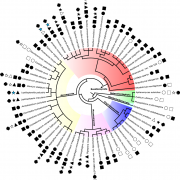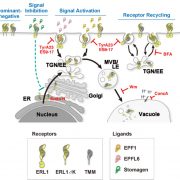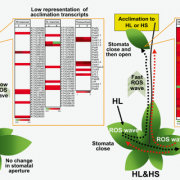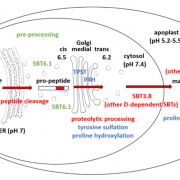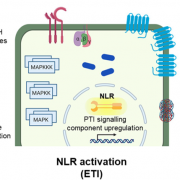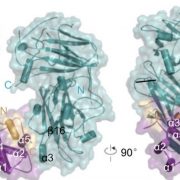RALF1-FERONIA complex affects splicing dynamics to modulate stress responses and growth in plants (Sci. Adv.)
 Alternative splicing is a process that can produce two or more transcript isoforms from a single gene and can increase protein diversity. FERONIA (FER) is a receptor-like kinase that serves as a receptor for the rapid alkalinization factor (RALF) peptides that regulate multiple cellular activities in response to biotic and abiotic stresses. Wang et al. investigated signalling downstream of RALF and FER. Upon RALF1 treatment, more than 3000 genes show alternative splicing events, including many that are stress-regulated or involved in amino acid biosynthesis. The authors screened for proteins that interact with the FER receptor and identified a splicing factor glycine-rich RNA binding protein7 (GRP7). FER interacts with and phosphorylates GPR7 in a RALF-dependent manner. Phosphorylated GRP7 translocates into the nucleus and shows increased RNA-binding activity to its target mRNAs. Upon ABA treatment, fer-4 and grp7 mutants show stronger root inhibition than the wild type, indicating that they play a negative role in ABA responses. Interestingly, ABA treatment leads to an increase of alternatively-spliced GRP7 transcripts, and induces its degradation via nonsense-mediated mRNA decay (NMD), suggesting a mechanism for fine-tuning this pathway. (Summary by Min May Wong @WongMinMay) Science Advances 10.1126/sciadv.aaz1622
Alternative splicing is a process that can produce two or more transcript isoforms from a single gene and can increase protein diversity. FERONIA (FER) is a receptor-like kinase that serves as a receptor for the rapid alkalinization factor (RALF) peptides that regulate multiple cellular activities in response to biotic and abiotic stresses. Wang et al. investigated signalling downstream of RALF and FER. Upon RALF1 treatment, more than 3000 genes show alternative splicing events, including many that are stress-regulated or involved in amino acid biosynthesis. The authors screened for proteins that interact with the FER receptor and identified a splicing factor glycine-rich RNA binding protein7 (GRP7). FER interacts with and phosphorylates GPR7 in a RALF-dependent manner. Phosphorylated GRP7 translocates into the nucleus and shows increased RNA-binding activity to its target mRNAs. Upon ABA treatment, fer-4 and grp7 mutants show stronger root inhibition than the wild type, indicating that they play a negative role in ABA responses. Interestingly, ABA treatment leads to an increase of alternatively-spliced GRP7 transcripts, and induces its degradation via nonsense-mediated mRNA decay (NMD), suggesting a mechanism for fine-tuning this pathway. (Summary by Min May Wong @WongMinMay) Science Advances 10.1126/sciadv.aaz1622


